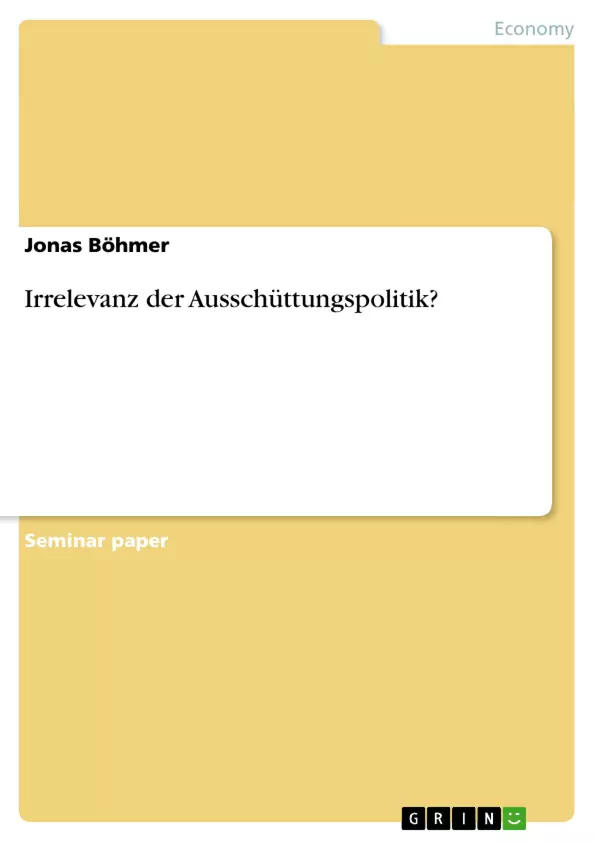In 1961, Miller and Modigliani (abbreviated MM) contrived that the distribution policy of a company is, under certain circumstances, not able to influence its share value, i.e. that the dividend policy is irrelevant. As long as a company distributes the full present value of its cash flow, it is not relevant how or in which period it does this in detail. Linda and Harry DeAngelo (D&D) on the other hand found that Miller and Modigliani were wrong. They say that the model of MM is unnecessary restrictive. In such a way that it even produces false and warped results. After relaxing some assumptions of MMs model, they get a contrary result. In their opinion payout policy is not irrelevant. They say that when retention is allowed it is very well important and relevant which dividend policy a company chooses.
Both points of view got a certain amount of support in the aftermath of their publishing. Prominent authors supporting MM were for example Joseph Stiglitz and Mark Rubinstein, while Myron Gordon and James Walter argued against it. But which is the right position? Is it afterall possible to answer this with certainty?
Probably not. Maybe it will last years to get a definite answer; if there will ever be one. None-theless this term paper will try to get some clarity onto that matter. Therefore the expose will start in chapter 2 with a review of Miller and Modigliani’s proof of irrelevancy. After this, in chapter 3 there will be a presentation of the contrasting thesis, most recently emphasized by DeAngelo and DeAngelo, who relax the critical assumption of no retention. In chapter 4 there will be a discussion of the consequences for the market participants if retention is allowed, brought forward alongside with its consequences for payout relevancy.
This paper will conclude by weighing the most important arguments of both sides. As it will not succeed in letting the scale tip, so gives an outlook on possible extensions of the MM valuation model. This will at least show the angles where both points of view gainsay the reality up to now.
Inhaltsverzeichnis (Table of Contents)
- Introduction
- Scale A-Irrelevance
- Key assumptions of the model
- Perfect capital markets
- Rationality
- Perfect certainty
- Miller/Modigliani share valuation
- Key assumptions of the model
- Scale B Relevance
- Gordon and Walter
- DeAngelo/DeAngelo's full payout
- Consequences of retention
- A scale in balance - Conclusion
Zielsetzung und Themenschwerpunkte (Objectives and Key Themes)
This paper aims to analyze the influence of dividend policy on a company's value. It explores the contrasting theories of Miller and Modigliani, who argue for dividend irrelevancy, and DeAngelo and DeAngelo, who advocate for payout policy relevance.- Dividend irrelevancy vs. dividend relevance
- Assumptions of perfect capital markets, rationality, and perfect certainty
- The role of retention in dividend policy
- Consequences of retention for market participants
- Valuation of a company's shares
Zusammenfassung der Kapitel (Chapter Summaries)
- The introduction presents the core question of the paper: whether dividend policy influences a company's value. It highlights the opposing viewpoints of Miller and Modigliani (MM) and DeAngelo and DeAngelo (D&D).
- Chapter 2 examines Miller and Modigliani's proof of dividend irrelevancy, outlining the key assumptions of their model: perfect capital markets, rationality, and perfect certainty. It further delves into the MM share valuation model, which explores how investors participate in a company's financial development.
- Chapter 3 presents the opposing thesis of DeAngelo and DeAngelo, who challenge MM's theory by relaxing the assumption of no retention. They argue for the relevance of payout policy, citing Gordon and Walter's work and their own concept of full payout.
- Chapter 4 discusses the consequences of allowing retention for market participants, exploring its impact on the relevancy of payout policy.
Schlüsselwörter (Keywords)
The primary keywords and focus topics of the paper include dividend policy, company valuation, Miller and Modigliani, DeAngelo and DeAngelo, perfect capital markets, rationality, perfect certainty, retention, payout policy, and share valuation.- Citar trabajo
- Diplom Volkswirt Jonas Böhmer (Autor), 2007, Irrelevanz der Ausschüttungspolitik?, Múnich, GRIN Verlag, https://www.grin.com/document/135690



